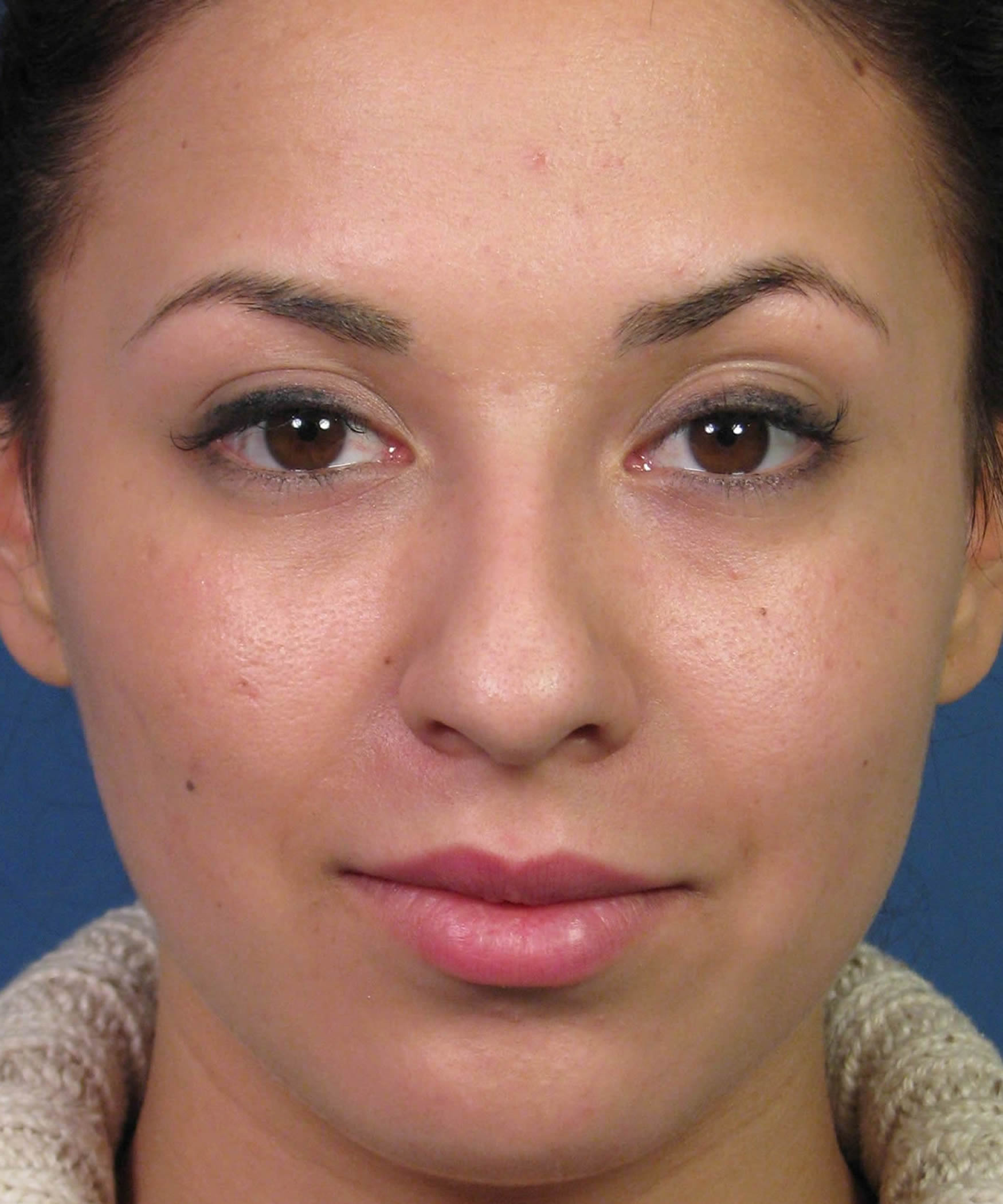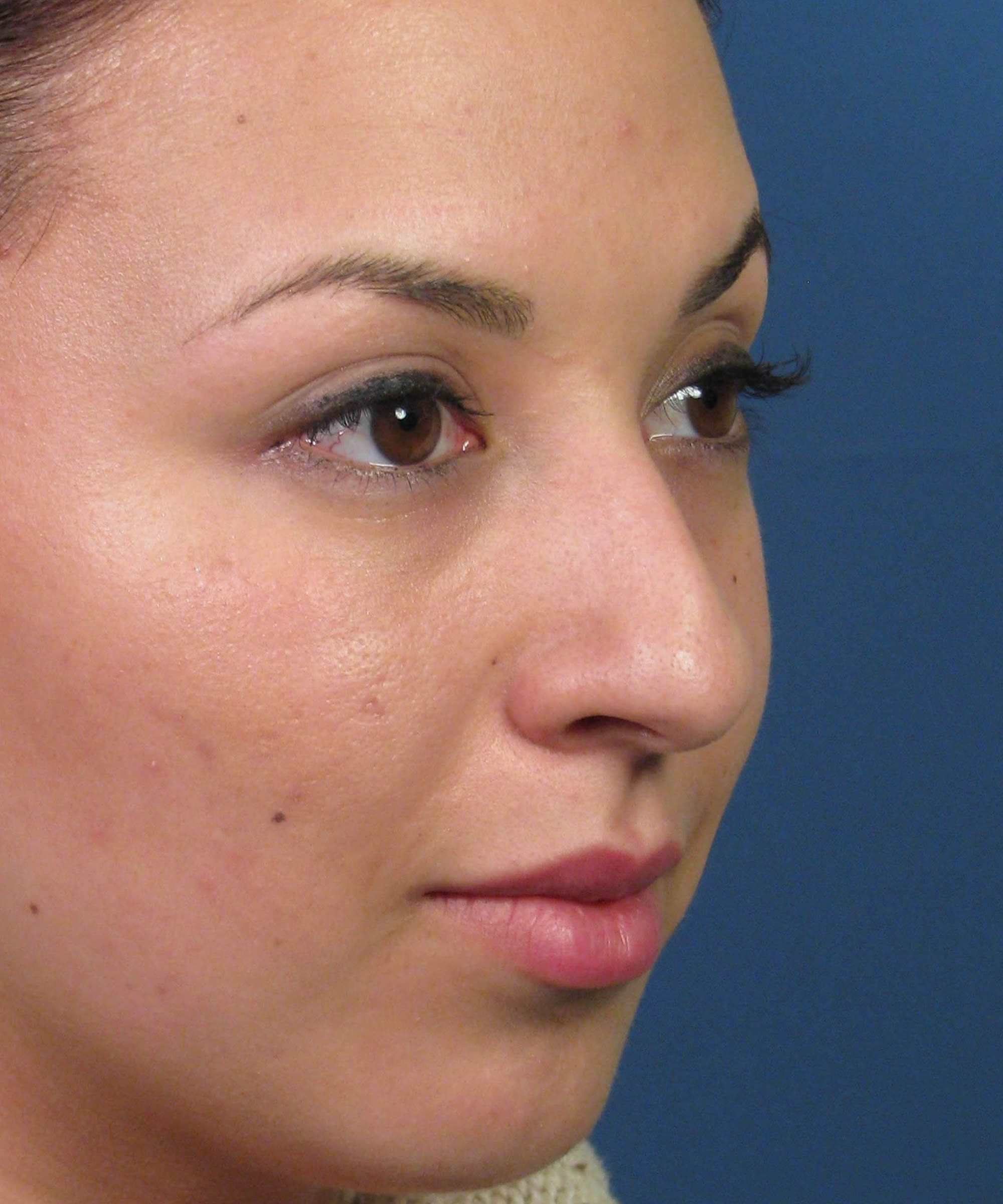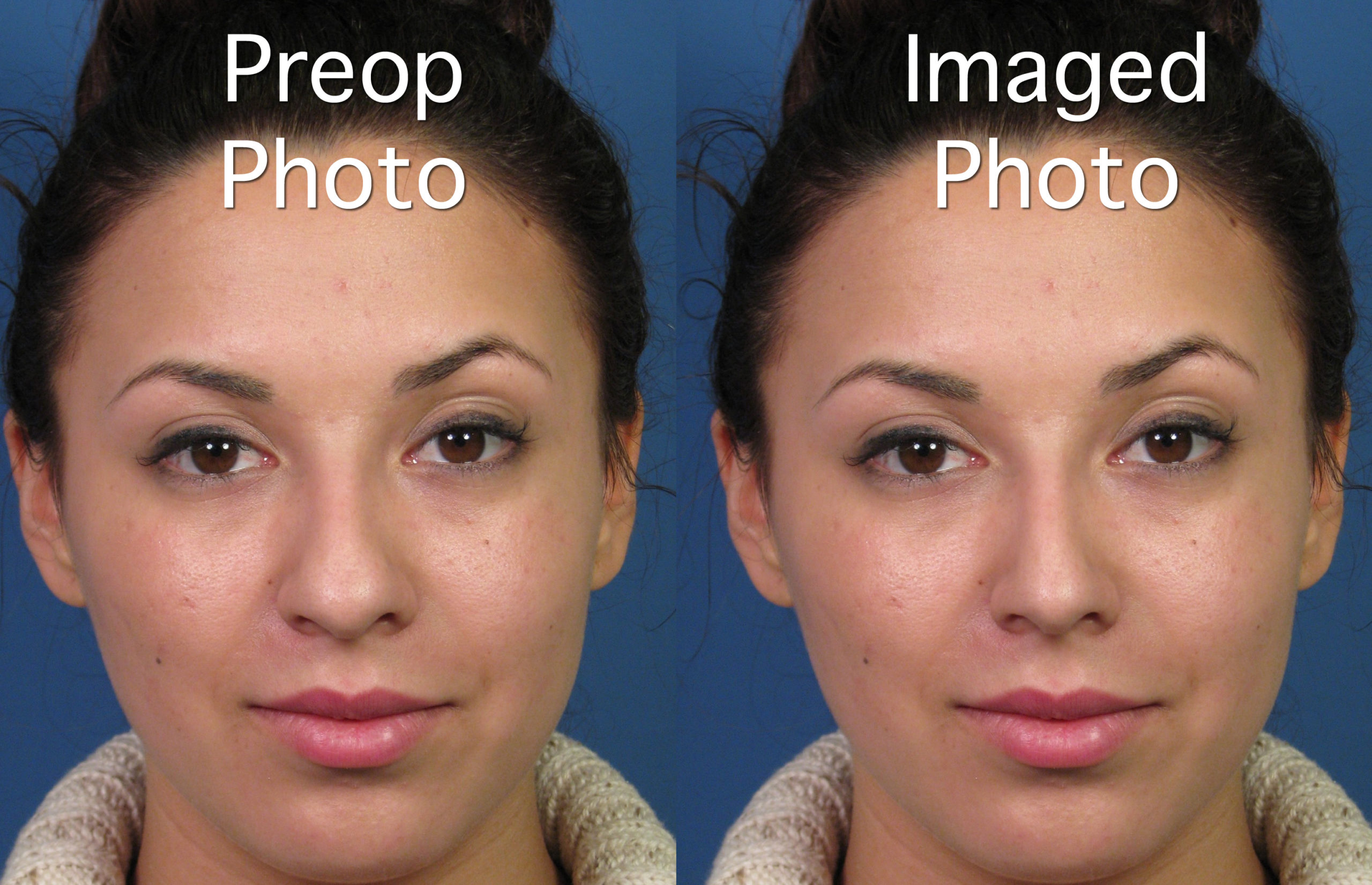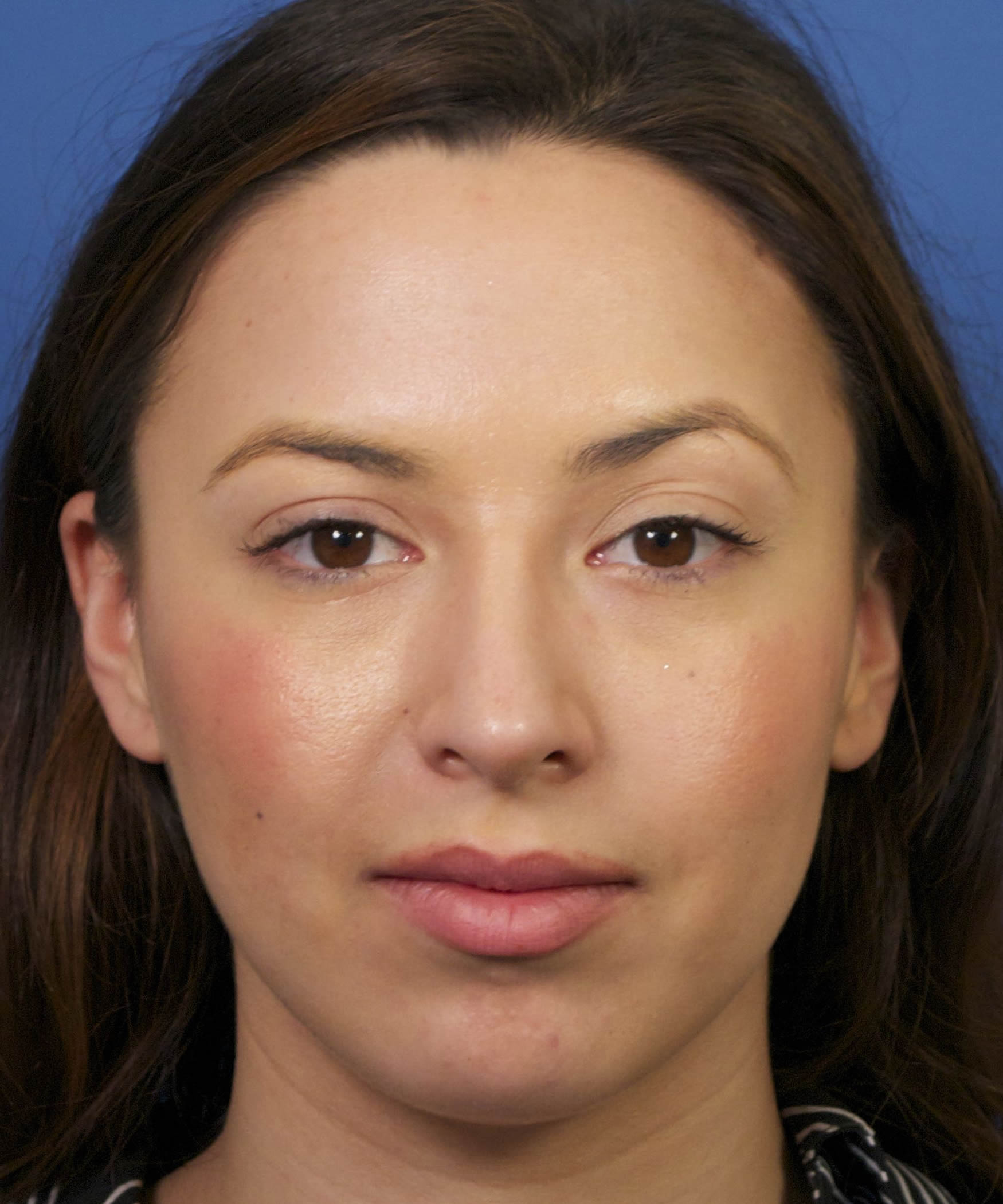This is another example of cosmetic nose reshaping, or rhinoplasty, to correct a bulbous, wide nasal tip. This very pleasant young lady consulted with me to discuss options for her bulbous appearing nasal tip. Although she also desired to address a bump on her nasal bridge, the bulbous nasal tip was considered a priority for her.
Bulbous Wide Nasal Tip Consult



During her examination in the office, we discussed in detail the desired changes to be made. More specifically, we discussed the fact her nasal tip did indeed appear somewhat bulbous as seen on her frontal view. Many patients and rhinoplasty surgeons would also describe this type of nasal tip as being broad or rounded in shape. As you look at her oblique, or 45 degree, angle the nasal bridge starts to come into view partially revealing the dorsal hump, or bump. This then becomes much more obvious as you look at the true lateral view of her nose. On her lateral view, you can also appreciate that her nasolabial angle (the angle formed by the bottom of the nose and the upper lip) is near 90 degrees. Ideally this angle would be closer to 95-105 degrees in a female.
Bulbous Wide Nasal Tip Imaging
As is done with a great majority of my cosmetic rhinoplasty procedures, digital imaging was performed using a specialized software program that allowed her photos to be morphed. In doing so, the patient and myself were able to get an idea of how the nose may look following surgery. The morphed photos are by no means a guarantee or warranty of what the nose will look like after rhinoplasty surgery. Instead, the morphed images are intended to be a guide in terms of the desired direction and degree of change.
It deserves mention that all the imaging in my office is performed by me – the surgeon. This is because I am the one who has been trained to do this type of surgery and is ultimately performing your surgery. In many other plastic surgery practices, a patient consultant (or some other staff member) is the one performing your imaging, which has never made sense to me. How can someone who has never performed a rhinoplasty procedure be qualified to show you realistic changes that will occur with very specific surgical maneuvers? This does not even touch on the wide variability in, for example, skin type and cartilage thickness that is seen across every individual.
In this particular case, I performed digital imaging to produce the photos shown below. As you can appreciate, the surgical goal was to make her nasal tip more narrowed. However, we wanted to maintain some degree of roundness, or convexity, to the nasal tip. On the side view, the goal was to reduce the dorsal hump, or bump, while creating a relatively straight profile. The desire was not to create a bridge that appeared excessively done or scooped on the side view. This was particularly important given the fact she has moderately strong ethnic features.
Bulbous Tip Reshaping
Once we had agreed on the desired surgical goals based largely on the software imaging, the surgery was scheduled and completed at our own ambulatory surgery center.
A reproduction of the ‘rhinoplasty diagram’ for this case is shown here. Rhinoplasty diagrams are typically done for each rhinoplasty surgery performed in my practice. These are essentially intra-operative ‘notes’ that are made to graphically show what was done to the nose during the rhinoplasty procedure. Although an actual operative report is dictated for each case, these rhinoplasty diagrams provide a valuable record that can be easily referenced to ‘see’ what was done. Why is this needed you may ask? Here is an example of why a rhinoplasty diagram may be helpful. Let’s say a patient is being seen 9-12 months out from surgery and notes a small visible bump near the middle portion of the nasal bridge that developed over the prior 4 weeks. In this situation I can easily reference the rhinoplasty diagram to check and see if this area corresponds to a graft or suture that was placed during surgery. Although the operative dictation may mention this, the graphical diagram is a more helpful reference.
 In this particular patient, an open rhinoplasty approach was used because it provided a marked advantage in terms of access and exposure from the nasal tip up to the radix. The excess bridge height was addressed by rasping the bone and shaving down the cartilage. This is represented by the red dotted line seen on the profile view of the diagram. Once this was ‘sanded down’ as patients often say, the nasal bones (essentially the upper one-third of the nose) were narrowed to help maintain a nice narrowed bridge. This is shown in the diagram as the curved yellow broken lines.
In this particular patient, an open rhinoplasty approach was used because it provided a marked advantage in terms of access and exposure from the nasal tip up to the radix. The excess bridge height was addressed by rasping the bone and shaving down the cartilage. This is represented by the red dotted line seen on the profile view of the diagram. Once this was ‘sanded down’ as patients often say, the nasal bones (essentially the upper one-third of the nose) were narrowed to help maintain a nice narrowed bridge. This is shown in the diagram as the curved yellow broken lines.
Attention was then focused on her bulbous, wide nasal tip. As mentioned in other rhinoplasty tutorials, there are a number of options available when dealing with a bulbous nasal tip. In this case, a decision was made to address the wide supra-tip region using cephalic trimming technique. In a majority of cases, I try and avoid this type of maneuver if possible. However, there are those cases, such as this one, where you simply have to reduce the amount, or volume, of excess cartilage that is contributing to nasal tip appearing bulbous and wide. Cephalic trimming essentially involves cutting out a narrow segment of the offending cartilage contour. The cephalic trimming of the supra-tip is represented in the diagram by the red shaded areas along the upper border of the lower lateral cartilages. Once this was done, a spanning suture was placed as shown by the green oval in the diagram. This special permanent shaping suture help to stabilize the cut edges of cartilage while also providing additional narrowing in the supra-tip.
Although these maneuvers certainly helped, additional reshaping of the nasal tip was warranted. This was performed with use of cartilage grafting technique. This means that cartilage is taken from one area and relocated to another area in order to change the shape of the nose. In this case example, cartilage was harvested from the septum as shown by the partially transparent red shaded outline. Septal cartilage is a common source of grafting in rhinoplasty since it is readily available inside of the nose. In rhinoplasty cases where the septum has been previously operated on, other sources of cartilage need to be sought out, such as the ear and rib. Fortunately, in this patient, the septum provided an adequate amount of cartilage to create the desired grafts. Using this cartilage, a cap graft was sewn over the native tip cartilage (as shown by the orange shaded area) to create improved projection and refinement. The overall effect of this type of reshaping was to provide a more narrow, defined look while also rotating the nasal tip (see yellow curved arrow).
In order to fine tune her profile, a small radix graft was also placed as shown by the orange shaded area near the top of the nasal bridge.
Bulbous Wide Tip Rhinoplasty
The results of her rhinoplasty surgery are shown here. As you can see on the frontal view, the nose has now been narrowed nicely to erase signs of her prior bulbous, wide nasal tip. But notice how her nasal tip remains slightly convex in shape without any hint of being pinched on the sides. If you look closely at her bridge on the frontal view you can also tell that her native width has been appropriately preserved.
On her oblique view you can start to see how the dorsal hump deformity (bump) has now been corrected. As you look from this angle you can now appreciate that her nose has been reshaped to give a more feminine contour overall. This includes narrowing of her bulbous tip and increasing the rotation of the nose.
On her lateral, or profile, view, you can see even more dramatic changes to the shape of the nose. Most obvious is improvement in the dorsal hump deformity. Her bridge is now much straighter without any stigma of being over-reduced, or scooped. Her nasal tip is also not as droopy as it appeared prior to the rhinoplasty.
Most importantly, this patient still looks like herself following rhinoplasty. Patients are so often concerned and worried about look too different after cosmetic nose reshaping. In cases like this one, the underlying ethnicity must also be respected in terms of any changes made to the nose. The end result and goal should be a nose that simply does not draw any unwanted attention to it any longer. In this particular case example, I happen to think that goal was certainly achieved as she now has a beautiful new nose that simply looks natural on her face.
Comparing Morphed Imaged Photos
Comparing her preoperative morphed images with the actual surgical results, you can see that the real-life outcome is fairly close to the predicted shape. It is unrealistic to think the actual result will be exactly like the morphed image. However, in a good majority of my rhinoplasty cases, the actual result can be considered fairly close to what was imaged prior to the planned surgery.
Consult for a Bulbous Wide Nasal Tip
If you have concerns with a bulbous, wide nasal tip and desire to have cosmetic rhinoplasty to reshape your nose, contact my office today for a personalized consultation.










